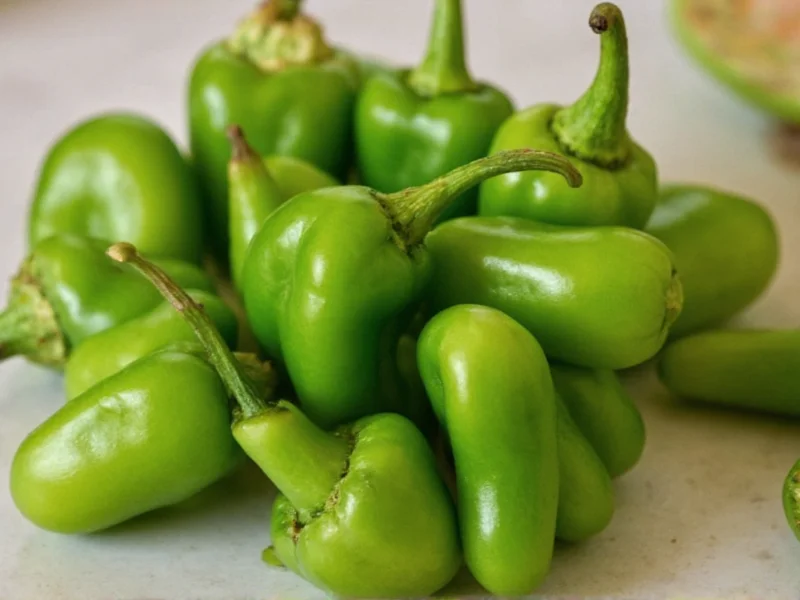Understanding exactly how hot serrano peppers are requires context beyond just numbers. These slender, bright green peppers deliver a clean, grassy heat that builds quickly but doesn't linger as long as some hotter varieties. The serrano pepper heat level can vary considerably based on growing conditions, with stress factors like limited water actually increasing capsaicin production.
Decoding the Scoville Scale for Serrano Peppers
The Scoville scale measures chili pepper pungency by determining how much sugar-water is needed to neutralize the heat. When asking serrano pepper how hot, the official range is 10,000-23,000 SHU, though most supermarket serranos test around 15,000 SHU. This scientific measurement provides objective data that helps cooks anticipate the pepper's impact in recipes.
Serrano Pepper Characteristics Beyond Heat
Beyond their notable heat, serrano peppers offer distinctive qualities that make them valuable in cuisine:
- Flavor profile: Bright, vegetal notes with citrus undertones
- Physical characteristics: 1-4 inches long, smooth skin, conical shape
- Color varieties: Green (most common), red, brown, orange, and yellow when fully ripe
- Texture: Crisp flesh ideal for both raw and cooked applications
Comparing Serrano Pepper Heat to Other Common Varieties
Understanding how hot are serrano peppers compared to jalapeños requires seeing them in context. The table below shows where serranos fit within the broader pepper spectrum:
| Pepper Variety | Scoville Heat Units (SHU) | Heat Relative to Serrano |
|---|---|---|
| Bell Pepper | 0 SHU | 0x (No heat) |
| Jalapeño | 2,500-8,000 SHU | 2-6x milder than serrano |
| Serrano | 10,000-23,000 SHU | Baseline |
| Cayenne | 30,000-50,000 SHU | 1.5-2x hotter than serrano |
| Habanero | 100,000-350,000 SHU | 5-15x hotter than serrano |
Factors That Influence Serrano Pepper Heat Level
Several variables affect the actual heat you'll experience when using serrano peppers:
- Growing conditions: Peppers grown in stressful environments (less water, hotter temperatures) develop higher capsaicin levels
- Ripeness: Red serranos (fully ripe) tend to be slightly hotter than green ones
- Plant position: Peppers growing in direct sunlight often develop more heat
- Individual variation: Even on the same plant, heat can vary significantly between peppers
- Preparation method: Removing seeds and membranes reduces heat substantially
Practical Handling and Usage Tips
When working with serrano peppers, consider these evidence-based recommendations:
- Protection: Wear gloves when handling, especially when cutting multiple peppers
- Cutting technique: Work in a well-ventilated area and avoid touching your face
- Heat reduction: Soak sliced peppers in vinegar or citrus juice to moderate heat
- Cooking impact: Heat intensifies slightly when raw but mellows when cooked
- Storage: Refrigerate whole peppers for up to three weeks or freeze for longer storage
Serrano Pepper Substitution Guide
If you're wondering are serrano peppers hotter than jalapeños (they are, typically 2-6 times hotter), here's how to substitute effectively:
- For milder heat: Use 1.5-2 jalapeños for every serrano called for in a recipe
- For similar heat: Thai bird chilies work well but require careful measurement
- For hotter applications: 1 serrano equals approximately 0.3-0.5 habaneros
- For dried alternatives: 1 fresh serrano ≈ ½ teaspoon crushed red pepper flakes
Understanding Capsaicin Distribution
Contrary to popular belief, the seeds themselves don't contain the highest concentration of capsaicin. The white pith (placenta) that holds the seeds contains the highest concentration of capsaicinoids. When preparing serrano peppers for serrano pepper heat level control, carefully remove this inner membrane for a milder result. The flesh contains minimal capsaicin, while the seeds absorb heat from contact with the placenta.
Regional Variations in Serrano Heat
Serrano peppers grown in their native Mexico often test at the higher end of the heat spectrum (18,000-23,000 SHU), while those cultivated in California and other US regions typically fall in the 10,000-16,000 SHU range. This variation explains why some cooks report significant differences in how hot serrano peppers are depending on their source. Commercial growers sometimes select for milder varieties to appeal to broader markets, further contributing to inconsistency.
Frequently Asked Questions
How much hotter are serrano peppers than jalapeños?
Serrano peppers are typically 2-6 times hotter than jalapeños. While jalapeños range from 2,500-8,000 Scoville units, serranos measure 10,000-23,000 SHU. In practical terms, one serrano pepper often provides the same heat as 2-3 jalapeños in recipes.
Can you eat serrano peppers raw?
Yes, serrano peppers can be eaten raw and are commonly used this way in salsas, guacamole, and as garnishes. Their heat is immediately noticeable but doesn't linger as long as some hotter peppers. Those sensitive to spice should remove seeds and membranes before consuming raw.
Why are some serrano peppers hotter than others?
Serrano pepper heat varies due to growing conditions (water stress increases heat), ripeness (red peppers are often hotter), position on the plant (sun-exposed peppers develop more capsaicin), and genetic variation. Even peppers from the same plant can show significant heat differences.
How do you reduce the heat of serrano peppers?
To reduce serrano pepper heat, remove all seeds and the white membrane (placenta) where most capsaicin concentrates. Soaking sliced peppers in vinegar or citrus juice for 10-15 minutes can further reduce heat. Cooking also mellows serrano heat slightly compared to raw applications.
What's the best way to store serrano peppers?
Store whole serrano peppers in a paper bag in the refrigerator's vegetable drawer for up to three weeks. For longer storage, freeze whole or sliced peppers in an airtight container for 6-8 months. Pickling is another excellent preservation method that also slightly reduces heat intensity.











 浙公网安备
33010002000092号
浙公网安备
33010002000092号 浙B2-20120091-4
浙B2-20120091-4